Neisseria sicca
N. sicca (Diplococcus pharyngis siccus) was described in 1906 by von Lingelsheim. This species was also recognized by Elser and Huntoon (1909) and Gordon (1921). Because of the variability in acid production patterns observed in early studies, Wilson and Smith (1928) recommended that N. sicca be grouped with M. catarrhalis, N. subflava biovar flava, N. cinerea, and N. mucosa in the species Neisseria pharyngis.
In the 1960s, Berger and co-workers showed that Neisseria spp. produced consistent patterns of acid production from carbohydrates if isolates were tested in an appropriate medium, a medium with a low protein to carbohydrate ratio with phenol red as the pH indicator. Although N. sicca, N. subflava biovar perflava, and exhibit identical acid production patterns. Although N. mucosa may be differentiated from the N. sicca, N. subflava biovar perflava by a nitrate reduction test, there are no biochemical methods for differentiating between these latter species. Berger and co-workers showed that N. subflava biovar perflava and N. sicca were serologically distinct.
According to Bergey's Manual, strains of N. sicca form dry, wrinkled, adherent colonies although smooth variants may occur. Most strains are not pigmented although some strains may be pigmented. It has been the author's experience that strains of N. sicca consistently fail to produce dry, wrinkled, adherent colonies. Lack of pigmentation appears to be a more reliable characteristic for differentiating between N. sicca and N. subflava biovar perflava. It is clear that there is a need for reliable tests for differentiating between these species.
Table 1. Characteristics of N. sicca
| Characteristic | Illustration |
|---|---|
| Gram stain Cell Morphology | Gram-negative diplococcus |
| Colony Morphology | 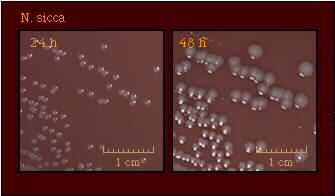 |
| Pigmentation | 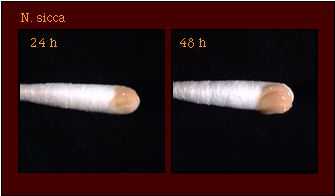 |
| Oxidase Test | 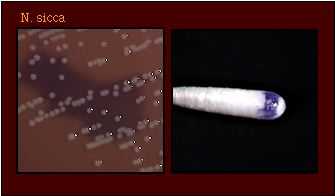 |
| Acid Production |  |
| Enzyme Substrate Test | Prolyl aminopeptidase +ve |
| Nitrate Reduction Test | Nitrate -ve |
| Polysaccharide from Sucrose | 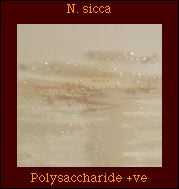 |
| Production of Deoxyribonuclease (DNase) |  |
| Superoxol Test (Reaction with 30% hydrogen peroxide) | 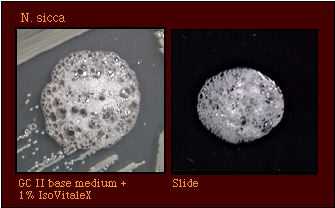 |
| Catalase Test | 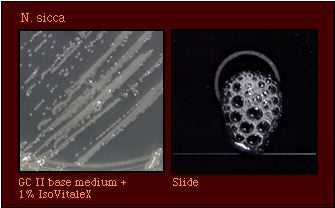 Catalase-positive |
| Colistin Resistance | 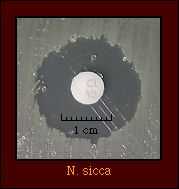 |
Species which may be misidentified as N. sicca in acid detection tests
Table 2. Characteristics of N. sicca and other Neisseria spp. that produce acid from glucose, maltose, and sucrose
| Species | Acid from | Nitrate Reduction | Poly- saccharide from Sucrose | Lipase | Superoxol | Pigment | Colistin Resistance* | ||||
|---|---|---|---|---|---|---|---|---|---|---|---|
| G | M | S | F | L | |||||||
| N. sicca | + | + | + | + | - | - | + | - | Weak (2+) positive | d | S |
| N. mucosa | + | + | + | + | - | + | + | - | Weak (2+) positive | d | S |
| N. subflava Biovar perflava | + | + | + | + | - | - | + | - | Weak (2+) positive | + | (R) |
Abbreviations: G, glucose; M, maltose, S, sucrose; F, fructose; L, lactose; +, most strains positive; -, most strains negative; d, strain-dependent; R, strains grow well on selective medium for N. gonorrhoeae and/or show no inhibition around a colistin disk (10 micrograms); (R), most strains susceptible, some strains resistant.
*Strains of N. sicca may form wrinkled colonies which adhere tightly to the surface of culture plates.
- Page last reviewed: March 31, 2017
- Page last updated: October 17, 2008
- Content source:


 ShareCompartir
ShareCompartir